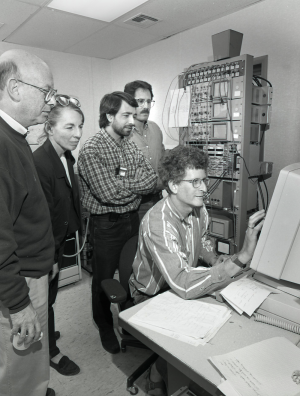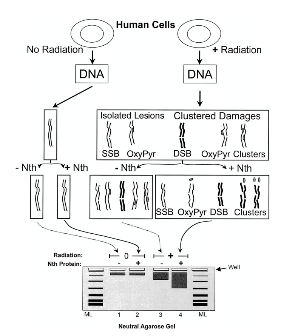In the mid-1990s, Betsy shifted her focus to DNA damage caused by ionizing radiation.
Francis Cucinotta was a senior scientist for the NASA Space Radiation Health Program when he first met Betsy in 1994. NASA had been interested in the biological effects of cosmic rays, to which astronauts could be exposed in space. To be able to conduct experiments on the effects of cosmic rays on human DNA, NASA built the NASA Space Radiation Laboratory in Brookhaven National Laboratory.
Unlike UV radiation, X-rays, and gamma rays, which are photons, cosmic rays consist of atomic nuclei traveling very fast. Cosmic rays impart large energies to biomolecules, unlike other radiation types. “We know what happens to humans when they are exposed to X-rays, but we had no similar data for cosmic rays” says Cucinotta, who is now a professor of health physics and diagnostic sciences at the University of Nevada, Las Vegas. “Betsy’s work showed how the DNA damage caused by cosmic rays is different.”
When cosmic rays hit DNA, they cause multiple damage at sites near each other. The clustering makes it difficult for natural repair to occur, leading to high rates of mutations.
A 2000 paper in PNAS on clustered DNA damage is one of Betsy’s top-three most cited papers.
The early years of the NASA program at Brookhaven were hectic and exciting. Experiments were conducted in the alternating-gradient synchrotron (AGS), which NASA rented for two weeks or so on a 24-by-7 basis.
John says Betsy scheduled her group to work in the middle of the night because if anything went wrong they were in a better position to troubleshoot. “I always tagged along because the experiments were so exciting,” says John, who took prepared samples into the target area.
“Getting in and out of the area required a retina scan,” John recalls. “A health physicist sat at a desk outside the door that led to the maze of shielding that led to the target room to give you a special radiation detector when you went in and take it back and read it when you came out. When the AGS is running at full power, a single ‘beam spill’ – and there was a spill roughly every 1.5 seconds – is a lethal dose.”
On Oct. 17, 2006, Betsy gives a videoconference seminar titled, “Endogenous and Radiation-Induced DNA Damage Clusters and Their Repair.” Archived in the National Institutes of Health Videocasting and Podcasting website, the video gives a rare opportunity to see and hear Betsy in action.
You can access the video here. Betsy first appears on the screen at around 38:00.
In the mid-1990s, Betsy shifted her focus to DNA damage caused by ionizing radiation.
Francis Cucinotta was a senior scientist for the NASA Space Radiation Health Program when he first met Betsy in 1994. NASA had been interested in the biological effects of cosmic rays, to which astronauts could be exposed in space. To be able to conduct experiments on the effects of cosmic rays on human DNA, NASA built the NASA Space Radiation Laboratory in Brookhaven National Laboratory.
Betsy had a key role in helping us design the experiments and the experimental areas. She helped make sure that people from outside Brookhaven could be successful in their experiment, and she oversaw all the people who carried out experiments in the space radiation lab.
Unlike UV radiation, X-rays, and gamma rays, which are photons, cosmic rays consist of atomic nuclei traveling very fast. Cosmic rays impart large energies to biomolecules, unlike other radiation types.
“We know what happens to humans when they are exposed to X-rays, but we had no similar data for cosmic rays” says Cucinotta, who is now a professor of health physics and diagnostic sciences at the University of Nevada, Las Vegas. “Betsy’s work showed how the DNA damage caused by cosmic rays is different.”
When cosmic rays hit DNA, they cause multiple damage at sites near each other. The clustering makes it difficult for natural repair to occur, leading to high rates of mutations.
A 2000 paper in PNAS on clustered DNA damage is one of Betsy’s top-three most cited papers.
The early years of the NASA program at Brookhaven were hectic and exciting. Experiments were conducted in the alternating-gradient synchrotron (AGS), which NASA rented for two weeks or so on a 24-by-7 basis.
John says Betsy scheduled her group to work in the middle of the night because if anything went wrong they were in a better position to troubleshoot.
“I always tagged along because the experiments were so exciting,” says John, who took prepared samples into the target area.
“Getting in and out of the area required a retina scan,” John recalls. “A health physicist sat at a desk outside the door that led to the maze of shielding that led to the target room to give you a special radiation detector when you went in and take it back and read it when you came out. When the AGS is running at full power, a single ‘beam spill’ – and there was a spill roughly every 1.5 seconds – is a lethal dose.”
When the AGS is running at full power, a single ‘beam spill’ – and there was a spill roughly every 1.5 seconds – is a lethal dose.
On Oct. 17, 2006, Betsy gives a videoconference seminar titled, “Endogenous and Radiation-Induced DNA Damage Clusters and Their Repair.” Archived in the National Institutes of Health Videocasting and Podcasting website, the video gives a rare opportunity to see and hear Betsy in action.
You can access the video here. Betsy first appears on the screen at around 38:00.
PUBLICATIONS


